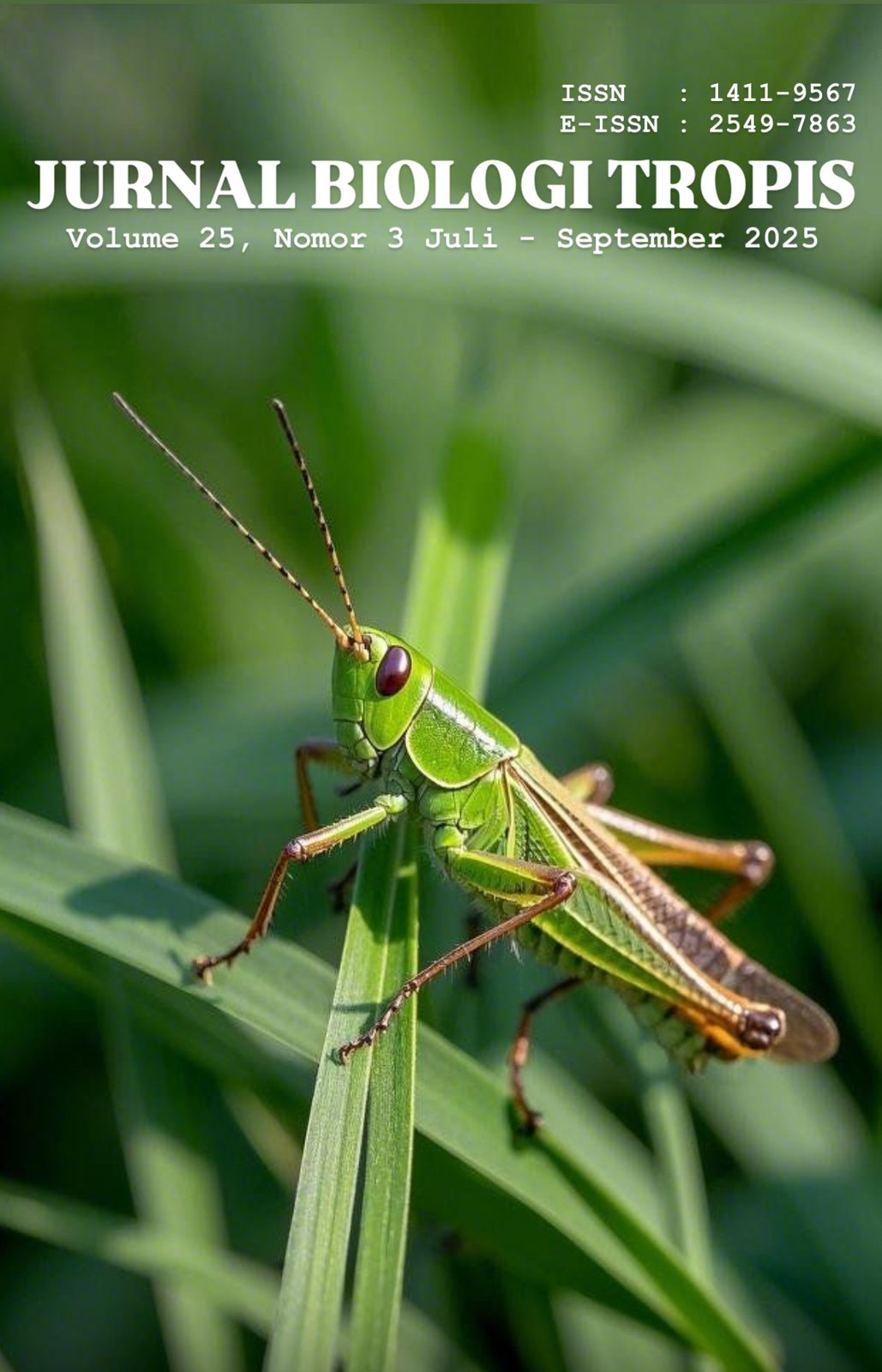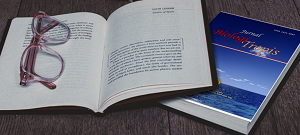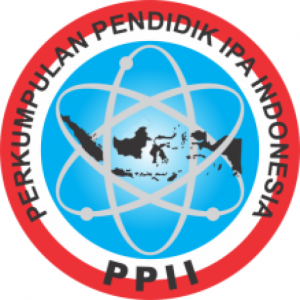Antimicrobial Activity of Starfruit Leaf Extract Against Gram-Positive and Gram-Negative Bacteria
Authors
Pauzan Pauzan , Edy Kurniawan , Nurul HafisahDOI:
10.29303/jbt.v25i3.9418Published:
2025-07-09Issue:
Vol. 25 No. 3 (2025): Juli-SeptemberKeywords:
Averrhoa bilimbi, antimikroba, Escherichia coli, ekstraksi, etil asetat, Staphylococcus aureus.Articles
Downloads
How to Cite
Downloads
Metrics
Abstract
Starfruit (Averrhoa bilimbi L.) is a plant traditionally used as medicine, mainly due to its secondary metabolite content that has the potential as an antimicrobial agent. This study aims to evaluate the antimicrobial activity of A. bilimbi leaf extract against Gram-positive Staphylococcus aureus and Gram-negative Escherichia coli bacteria. Extraction was carried out using three types of solvents: 100% ethanol, 100% ethyl acetate, and a mixture of ethanol-ethyl acetate (1:1) using the maceration method. Antimicrobial activity tests were carried out using the disc diffusion method to measure the inhibition zone of bacterial growth. The results showed that all A. bilimbi leaf extracts had inhibitory activity against both types of test bacteria. The extract with ethyl acetate solvent showed the largest inhibition zone against S. aureus and E. coli, followed by the mixed ethanol-ethyl acetate extract, and then the ethanol extract. These findings indicate that the active compounds in A. bilimbi leaves are more soluble in ethyl acetate and have the potential to be developed as natural antibacterial agents.
References
Adiwinoto, R. P. (2018). Empirical Antibiotic Therapy Assessment of Patients diagnosed with Sepsis in Intermediate Care Ward of Internal Medicine Department of Dr. Soetomo General Hospital according to Gyssens Method. Oceana Biomedicina Journal, 1(2), 69. https://doi.org/10.30649/obj.v1i2.17
Agustina, D., Indreswari, L., Tristianti, F. N., Milla, K. I. E., Hermansyah, B., Wahyudi, S. S., & Firdaus, J. (2020). MODULASI AKTIVITAS CIPROFLOXACIN TERHADAP Pseudomonas aeruginosa OLEH N-ASETILSISTEIN DAN VITAMIN C. Syifa MEDIKA Jurnal Kedokteran Dan Kesehatan, 11(1), 30. https://doi.org/10.32502/sm.v11i1.2389
Ahmed, I. A. (2017). Paradigm Shift: Focusing on Plant-Based Natural Antimicrobials. Journal of Microbiology & Experimentation, 5(2). https://doi.org/10.15406/jmen.2017.05.00145
Angelini, P. (2024). Plant-Derived Antimicrobials and Their Crucial Role in Combating Antimicrobial Resistance [Review of Plant-Derived Antimicrobials and Their Crucial Role in Combating Antimicrobial Resistance]. Antibiotics, 13(8), 746. Multidisciplinary Digital Publishing Institute. https://doi.org/10.3390/antibiotics13080746
Arifa, N., & Periadnadi, P. (2018). Antimicrobial Activity Of Fresh Extract Sikaduduak (Melastoma malabathricum Linn.). Metamorfosa Journal of Biological Sciences, 5(2), 165. https://doi.org/10.24843/metamorfosa.2018.v05.i02.p05
Asmilia, N., Abrar, M., Fahrimal, Y., Sutriana, A., & Husna, Y. (2020). Potential of Malacca leaf (Phyllanthus emblica) against Salmonella sp. E3S Web of Conferences, 151, 1029. https://doi.org/10.1051/e3sconf/202015101029
Aziizah, A. A., & Khuzaimah, S. (2022). EKSTRAKSI ZAT WARNA ALAMI DAUN KETAPANG (TERMINALIA CATAPPA) UNTUK PEWARNA SABUN PADAT BERBAHAN DASAR MINYAK JELANTAH. Jurnal Inovasi Daerah, 1(2), 135. https://doi.org/10.56655/jid.v1i2.32
Chandekar, C. J. (2018). Evaluation of Antibacterial Activity of Plant Extracts on Antibiotic Resistant Bacteria. International Journal of Current Microbiology and Applied Sciences, 7(12), 1164. https://doi.org/10.20546/ijcmas.2018.712.144
Isnaeni, D., Rasyid, A. U. M., & Rahmawati, R. (2021). Uji Efektivitas Ekstrak Etanol Daun Upo-upo (Phyllodium pulchellum (L.) Desv.) sebagai Antibakteri terhadap Pertumbuhan Streptococcus viridans dan Streptococcus pyogenes. MPI (Media Pharmaceutica Indonesiana), 3(3), 138. https://doi.org/10.24123/mpi.v3i3.3629
Juwairiah, J., & Roebiakto, E. (2022). The Effectiveness of Kirinyuh (Chromolaena odorata L.) Leaf Essential oil as an Antibacterial Staphylococcus aureus and Escherichia coli. Tropical Health and Medical Research, 4(2), 44. https://doi.org/10.35916/thmr.v4i1.64
Kurniawati, E., Wibowo, F. S., & Rusmeilina, R. (2021). AKTIVITAS PENANGKAPAN RADIKAL BEBAS PADA KOMBINASI EKSTRAK ETANOL DAUN MANGGA (Mangifera indica L.) DAN DAUN SIRSAK (Annona muricata L.). Cendekia Journal of Pharmacy, 5(1), 92. https://doi.org/10.31596/cjp.v5i1.125
Masruri, M., Pangestin, D. N., Ulfa, S. M., Riyanto, S., Srihardyastutie, A., & Rahman, Moh. F. (2018). A Potent Staphylococcus Aureus Growth Inhibitor Of A Dried Flower Extract Of Pinus Merkusii Jungh & De Vriese And Copper Nanoparticle. IOP Conference Series Materials Science and Engineering, 299, 12072. https://doi.org/10.1088/1757-899x/299/1/012072
Mohammad, N., Saleem, S., Balata, R., & Salih, D. (2022). Antibacterial activities of plant extract Cinnamomum zeylanicum bark against multidrug-resistant bacteria. Al-Mağallaẗ al-ʻirāqiyyaẗ Li-l-Ṣaydalaẗ, 18(2), 10. https://doi.org/10.33899/iphr.2022.170393
Mohsenipour, Z., & Hassanshahian, M. (2015). The inhibitory effect of Thymus vulgaris extracts on the planktonic form and biofilm structures of six human pathogenic bacteria. DOAJ (DOAJ: Directory of Open Access Journals), 5(4), 309. https://doaj.org/article/814d80a9615c41ad819e1fd542960426
Munasir, Z. (2016). Respons Imun Terhadap Infeksi Bakteri. Sari Pediatri, 2(4), 193. https://doi.org/10.14238/sp2.4.2001.193-7
Muthmainnah, R., Rubiyanto, D., & Julianto, T. S. (2016). Formulasi Sabun Cair Berbahan Aktif Minyak Kemangi Sebagai Antibakteri Dan Pengujian Terhadap Staphylococcus Aureus. Indonesian Journal of Chemical Research, 2(1), 44. https://doi.org/10.20885/chemical.vol2.iss1.art6
Oroh, S. B., Kandou, F., Pelealu, J., & Pandiangan, D. (2015). UJI DAYA HAMBAT EKSTRAK METANOL Selaginella delicatula DAN Diplazium dilatatum TERHADAP BAKTERI Staphylococcus aureus DAN Escherichia coli. JURNAL ILMIAH SAINS, 15(1), 52. https://doi.org/10.35799/jis.15.1.2015.8238
Robbia, A. Z., Yahdi, Y., & Dewi, Y. K. (2021). Perbandingan Pengaruh Ekstrak Lidah Buaya (Aloe vera) dan Ekstrak Daun Sirih (Piper betle Linn) Terhadap Kualitas Produk Hand Soap. JURNAL PIJAR MIPA, 16(2), 228. https://doi.org/10.29303/jpm.v16i2.2452
Sari, V. P., Retnowati, W., & Setiawati, Y. (2020). Uji aktivitas antibakteri ekstrak biji petai cina (Leucaena leucocephala) terhadap Staphylococcus aureus. Jurnal Kedokteran Syiah Kuala, 20(2). https://doi.org/10.24815/jks.v20i2.18501
Shintawati, S., Rina, O., & Ermaya, D. (2020). Sifat Antimikroba dan Pengaruh Perlakuan Bahan Baku terhadap Rendemen Minyak Sereh Wangi (Antimicrobial Properties and Effects of Raw Material Treatments on Citronella Oil Yield). Jurnal Sylva Lestari, 8(3), 411. https://doi.org/10.23960/jsl38411-419
Simorangkir, M., & Maha, A. P. (2020). Antibacterial Activity And Phytochemical Screening From Chromatography Fraction Of Ethanol Extract Of Sarang Banua (Clerodendrum fragrans Vent Willd) Against Salmonella enterica. Indonesian Journal of Chemical Science and Technology (IJCST), 3(2), 42. https://doi.org/10.24114/ijcst.v3i2.19525
Wahid, H., Sulaiman, A. W., Najamuddin, M., & Pratiwi, E. M. (2024). FORMULASI DAN UJI AKTIVITAS SEDIAAN PAPER SOAP SABUN CUCI TANGAN EKSTRAK ETANOL DAUN JAMBU BIJI (Psidium guajava L.) TERHADAP Staphylococcus aureus. Empiris., 1(2), 78. https://doi.org/10.62335/cdcehp13
Wahyudi, W., Indi, A., & Pagala, M. A. (2021). Gambaran Eritrosit, Hemoglobin dan Hematokrit Pada Ayam Ras Petelur Jantan yang Diberi Ekstrak Daun Mahkota Dewa (Phaleria macrocarpa). Jurnal Ilmiah Peternakan Halu Oleo, 3(2). https://doi.org/10.56625/jipho.v3i2.18023
Zhou, G., Wang, Q., Wang, Y., Wen, X., Peng, H., Peng, R., Shi, Q., Xie, X., & Li, L. (2023). Outer Membrane Porins Contribute to Antimicrobial Resistance in Gram-Negative Bacteria [Review of Outer Membrane Porins Contribute to Antimicrobial Resistance in Gram-Negative Bacteria]. Microorganisms, 11(7), 1690. Multidisciplinary Digital Publishing Institute. https://doi.org/10.3390/microorganisms11071690
License
Copyright (c) 2025 Pauzan Pauzan

This work is licensed under a Creative Commons Attribution 4.0 International License.

Jurnal Biologi Tropis is licensed under a Creative Commons Attribution 4.0 International License.
The copyright of the received article shall be assigned to the author as the owner of the paper. The intended copyright includes the right to publish the article in various forms (including reprints). The journal maintains the publishing rights to the published articles.
Authors are permitted to disseminate published articles by sharing the link/DOI of the article at the journal. Authors are allowed to use their articles for any legal purposes deemed necessary without written permission from the journal with an acknowledgment of initial publication to this journal.


























